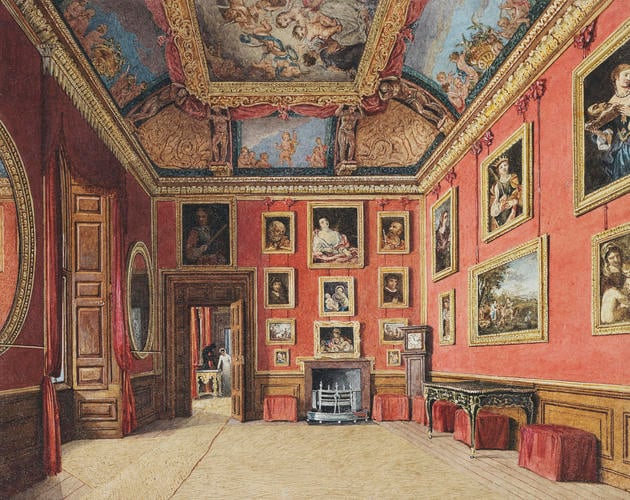Windsor Castle: The King’s Dressing Room c. 1816
Pencil, watercolour and bodycolour | 20.2 x 25.3 cm (sheet of paper) | RCIN 922105
-
A watercolour depicting the room adjacent to the King's Closet, featuring walls hung with crimson silk and gold beading and many paintings, a window to the left with oval mirrors on either sides, rush matting on floor and a ceiling painting. Prepared for one of the plates in William Henry Pyne's History of the Royal Residences (1816-1819); engraved by W.I. Bennett and the print published 1 October 1816.
The original ceiling painting in the King's Dressing Room was executed by Antonio Verrio and depicted Jupiter and Danae. However, this watercolour records the short-lived ceiling painting which replaced the Verrio before itself being removed in the 1830s; this was painted by Matthew Cotes Wyatt (James Wyatt’s son) and the subject was the suckling of the Infant St George.
Pyne's History of the Royal Residences was a three-volume publication which encompassed a number of royal residences, including Windsor Castle (vol. 1) and Buckingham House (vol. 2), presenting 100 hand-coloured engravings of exteriors and interiors accompanied by descriptive texts. The 100 watercolours which were engraved for the publication survive in the Royal Library; these watercolours are exactly the size of the image on the printed plates, and may perhaps have been intended as colour guides for the artists responsible for hand-painting the monochrome prints.
The King’s Dressing Room overlooks the North Terrace, between the King’s Bedchamber (to the east) and the King’s Closet (to the west). The room benefited from a considerable programme of refurbishment from the late 1790s. John Yenn’s design for four large oval giltwood mirrors - two for the Dressing Room and two for the Closet, shown by Pyne on the window wall in both cases - is in the Royal Collection. Three of these mirrors have also survived. According to instructions on Yenn’s drawing, which is undated, the frames were to be carved by Richard Lawrence, and the mirror plates were to be supplied by Robert Campbell. The furniture includes a fine French bureau-plat, probably dating from the 1740s. The table - which may have been acquired by George III - was used by Queen Victoria when she signed the Royal Assent to the Australian Commonwealth Bill in July 1900 and was subsequently sent by her, as a permanent memento, to Australia; it is now in Parliament House, Canberra.
The paintings visible here can be identified from the 1816 inventory of Windsor Castle. On the wall facing us the overdoor is Dahl’s portrait of an officer, then thought to be the Duke of Marlborough (405911). At the centre of this wall are three paintings, Guido Reni’s Cleopatra (405338), hanging above his Virgin and Child (403549), with Annibale Carracci’s ‘Il Silenzio’ (404762), resting on the mantle at the bottom. These three are framed by four pairs, two saints after Guercino across the top, St Peter (left, 405556) and St Paul (right, 405554); below these come Rembrandt’s Old Woman (left, 405000) and Savoldo’s Man with Hawk (right, 405764), below these two landscapes by Wouwermans, a Forge (left, 404299) and Country Road (right, 400679), across the bottom are two tiny Holy Families from the circle of Raphael, (left, 400676) and (right, 400606).
On the right hand wall (opposite the windows), three paintings are visible on the upper level: Carlo Dolci’s Magdalen (left, 405546) and Salome (right, 405639) and frame a studio of Reni St Catherine (upper middle, 405547). Below this two Guercino Madonnas (left, 402611 and right, 403985) frame Lauri’s Departure of Jacob (lower centre, 406356).
Catalogue entry adapted from George III & Queen Charlotte: Patronage, Collecting and Court Taste (London, 2004)Provenance
Probably acquired by George IV
-
Creator(s)
Acquirer(s)
-
Medium and techniques
Pencil, watercolour and bodycolour
Measurements
20.2 x 25.3 cm (sheet of paper)
Other number(s)
RL 22105Alternative title(s)
King's Dressing Room, Windsor Castle











